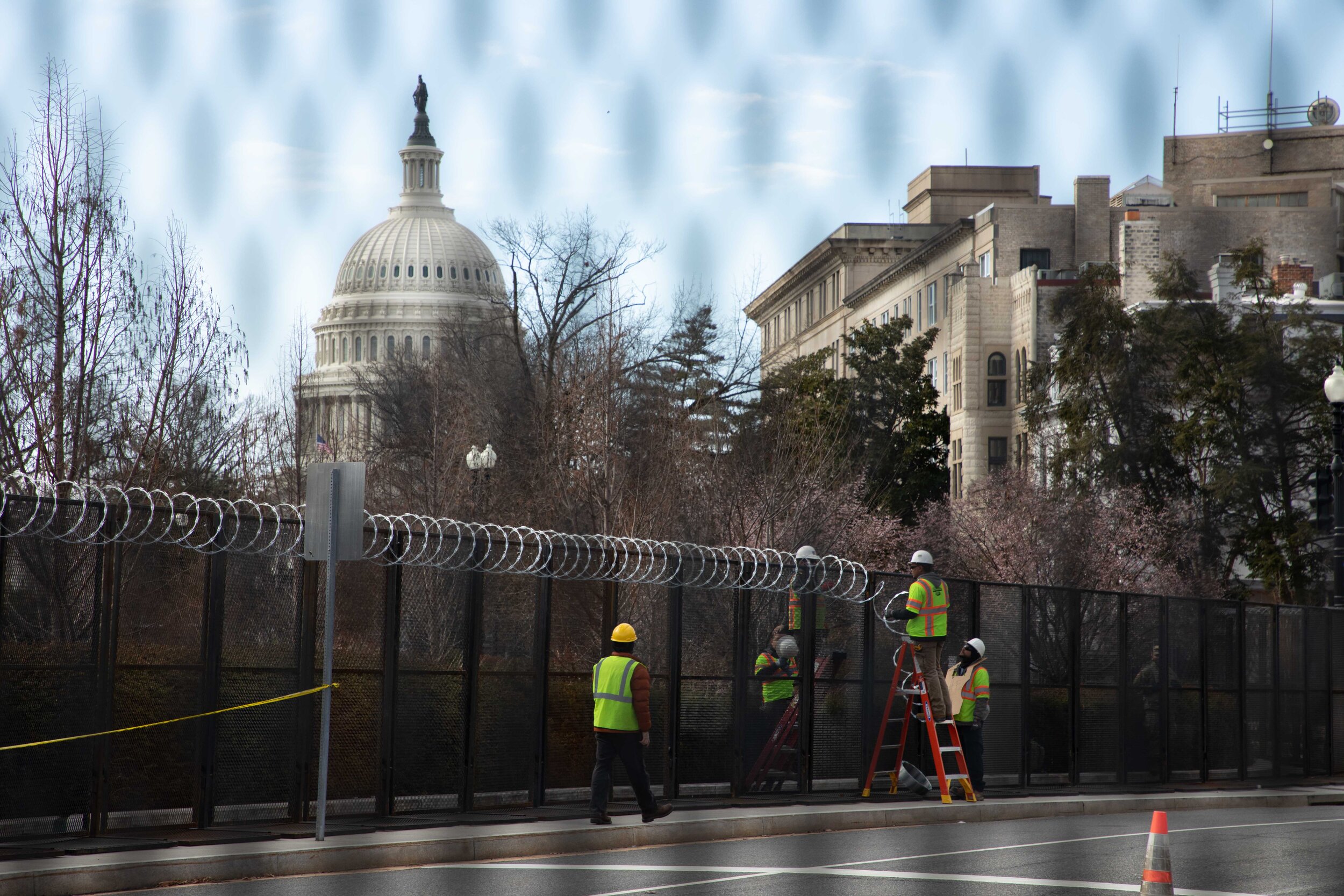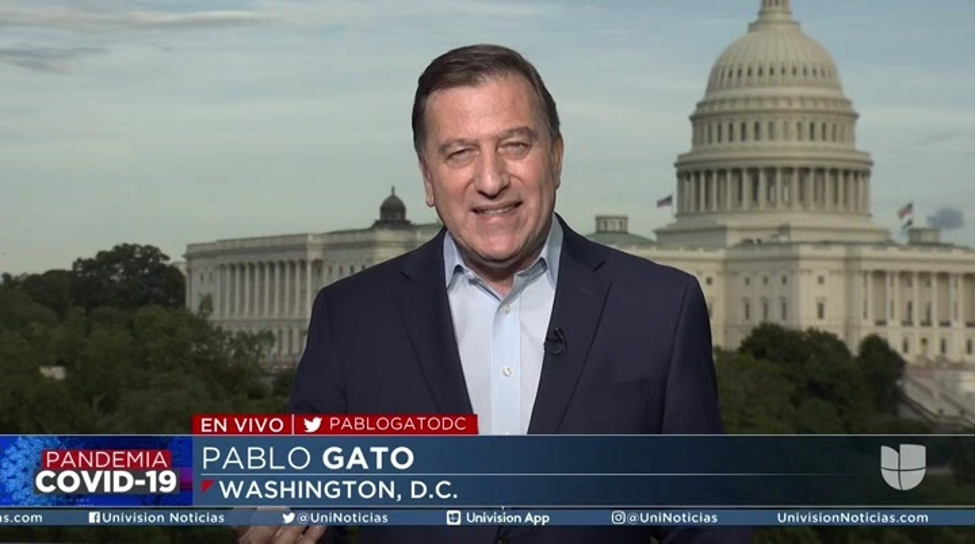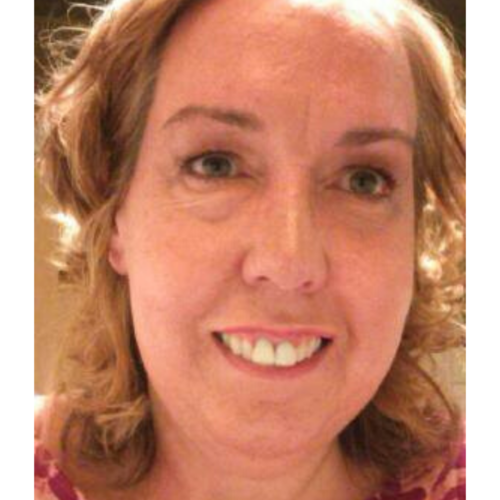Hostile Territory?
Some of the 25,000 soldiers and law enforcement deployed to the inauguration of Joe Biden monitor traffic on the National Mall. Photo by Zaydee Sanchez
Ahead of a presidential inauguration like no other, journalists marvel at having to prepare like they were going into a conflict zone
Pablo Gato has covered mass demonstrations and conflicts in far away places such as Afghanistan, Iraq, and Sarajevo. But the Univisión correspondent never imagined he’d be covering his home base of Washington, D.C. as though it were a conflict zone -- especially during a presidential inauguration.
Two weeks after he witnessed a mob overrun the country’s seat of government, Gato and his crew will be on the National Mall again, this time with a bodyguard.
“I’ve been in conflict zones around the world, just me and my cameraman,” Gato said. “But now to cover the inauguration, they’re giving us a bodyguard. I’ve never had one before.”
For the inauguration of President-elect Joe Biden, journalists like Gato will work in an atmosphere of unprecedented tension: More than 25,000 National Guard members and federal and local police are positioned in a massive ring around Washington’s core, from around the U.S. Supreme Court to the Potomac River behind the Lincoln Memorial and a wide area around the White House. Mass transit is shut down in a large part of the city and roads and bridges leading to the inauguration zone are closed until the day after the ceremony.
After the deadly January 6 assault by thousands of supporters of President Donald Trump, there is such anxiety in Washington, D.C. that the FBI is now vetting all of the security forces assigned to protect President-elect Joe Biden and the January 20 inauguration. There were reports that Defense Department officials feared an “insider” attack by a rogue sentinel.
“Never in the United States”
Several Latino journalists witnessed the unprecedented uprising two weeks ago. Despite their cumulative decades of experience covering conflict and violence around the globe, they were stunned. They said they’d never seen anything like what happened that day. Ahead of this week’s presidential inauguration, palabra. spoke with reporters about the assault on the Capitol, and what they now expect during the swearing-in of a new president and vice president.
The nation's capital is ringed by a line of military guards and some serious fences, ahead of Joe Biden's inauguration. Photo by Zaydee Sanchez
“The top floor of the Univisión bureau in Washington, D.C. is directly across from the U.S. Capitol and we could see how the mass of people just kept coming. I’ve been to all kinds of demonstrations and massive ones, including violent ones, but never in the United States over the results of a presidential election,” Gato told palabra.
Cristina Frey saw signs of trouble early on.
Frey is a freelance photographer for several news outlets. She had never seen demonstrators on U.S. soil clad in bulletproof vests, carrying military-style equipment, and walkie-talkies. “(It was) like they were in the middle of some kind of takeover, ready for a confrontation. There were a lot of people without masks, yelling, and I was thinking I’m in the middle of this and I could catch the coronavirus. I covered the Trump speech before everyone went over to the Capitol building and the whole thing felt surreal. He was pushing them to fight. It was surreal.”
That day – and into the evening -- María Rosa Lucchini worked through the angry mob and tear gas to cover the confrontations between police and Trump supporters for a Chilean television network.
A reporter’s view as the assault began on the Capitol building on Jan. 6. Photo by María Rosa Lucchini
“Previous demonstrations and protests always seemed to have a purpose and a mission behind them, but this one just seemed to be that their mission was violence, like they were looking for a fight,” Lucchini said.
“My press credential and camera have been for me a type of shield, but it felt completely different this time around, especially when I was recording in Spanish. But you know, what happened on January 6 was an accumulation of things over the past four years of the president’s attacks and rhetoric. It was like a bomb went off.” -- María Rosa Lucchini, independent journalist
A disaster foretold
The attack in Washington this month shouldn’t have surprised any reporter, said Rebecca Aguilar, president-elect of the Society of Professional Journalists (SPJ) and a former board member of the National Association of Hispanic Journalists.
“I find it very surprising and very alarming that some of the federal investigators are saying that they didn’t expect this to happen,” Aguilar said. “Mr. Trump did us journalists a lot of damage when he started with the fake news. But in the end you will see that journalists are still standing and Mr. Trump will leave his office a disgrace.”
And while authorities and federal lawmakers look into the insurgency that first week of January -- at least 124 people have been arrested and hundreds more are being investigated -- Gato said he remains puzzled by the lack of preparedness on that day.
Pablo Gato, Washington, D.C. correspondent for Univisión.
“It’s so unbelievable what the authorities have said that they didn’t expect it … The day before, I did a story where I talked with local businesses … that were closing up and boarding up because law enforcement told them they expected something to happen, including something violent,” Gato said. “We spoke to a restaurant owner who was boarding up his business because he was told that people were coming and that they were armed and violent. So, if an owner of a restaurant knows what’s going to happen and law enforcement authorities have told him, it’s surprising … how unprepared they were.”
Extra security - and bodyguards
The U.S. Capitol building assault has cast a pall over a presidential inauguration that Lucchini, an immigrant from Perú, had been looking forward to with special anticipation.
María Rosa Lucchini is an independent journalist based in Washington, D.C.
“I’ll be at the inauguration because my job is not to be on the sidelines,” Lucchini said. “I’ll definitely be more aware, but I’ll still do my job.”
Unlike previous event coverage, however, many journalists will not go to this inauguration alone.
“Yes, we’ve gotten to that point,” Lucchini added. “The press needs bodyguards to cover a presidential inauguration. Bodyguards at an inauguration. Think about that.”
“I’m not afraid because they’ll be extra security,” Frey said. “An inauguration is a historic event.”
Rebecca Aguilar is president-elect of the Society of Professional Journalists.
While the area around the U.S. Capitol today resembles a military encampment, no journalist should be afraid to do their job, said Aguilar, who has covered many dangerous events, including the 1992 Los Angeles riots.
“You have to be smart, you have to look over your shoulder, be alert and never let your guard down,” Aguilar said.
“All journalists can learn from the violence in the Capitol. No matter how heated, no matter how dangerous it is out there, the public can count on us as journalists on getting the story, that no one is going to hold us back, that no one is going to scare us away from an assignment.”
Patricia Guadalupe is a bilingual multimedia journalist based in Washington, D.C., and is the president of the DC chapter of NAHJ. She has covered the capital for more than 20 years. She contributes to NBC News.com and Latino Magazine, among others. She’s been an editor at Hispanic Link News Service (where she still writes political news), a reporter at WTOP Radio (CBS Washington affiliate), and contributing reporter for CBS Radio network. She is also an adjunct professor in the School of Communication at American University.








